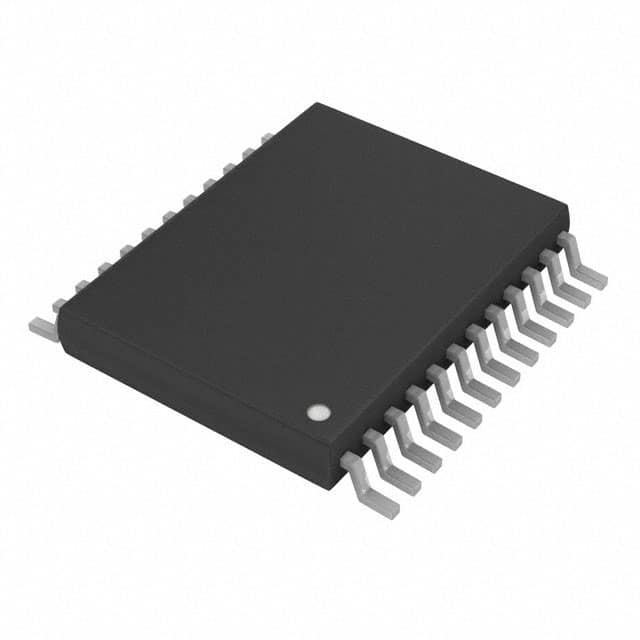Viz Specifikace pro podrobnosti o produktu.

SN74LVTH543DGVRE4
Product Overview
- Category: Integrated Circuit (IC)
- Use: Level Shifter and Bus Transceiver
- Characteristics: High-speed, low-voltage, and low-power consumption
- Package: TSSOP (Thin Shrink Small Outline Package)
- Essence: Bidirectional voltage level shifting and bus transceiver functionality
- Packaging/Quantity: Tape and Reel, 2500 units per reel
Specifications
- Logic Family: LVTH
- Number of Channels: 8
- Input Voltage Range: 1.65V to 3.6V
- Output Voltage Range: 1.65V to 3.6V
- Propagation Delay Time: 2.5ns (Max)
- Operating Temperature Range: -40°C to +85°C
Detailed Pin Configuration
The SN74LVTH543DGVRE4 has a total of 20 pins, which are assigned as follows:
- Pin 1: OE (Output Enable) for Channel 1
- Pin 2: A1 (Data Input/Output) for Channel 1
- Pin 3: B1 (Data Input/Output) for Channel 1
- Pin 4: GND (Ground)
- Pin 5: B2 (Data Input/Output) for Channel 2
- Pin 6: A2 (Data Input/Output) for Channel 2
- Pin 7: OE (Output Enable) for Channel 2
- Pin 8: VCC (Power Supply)
- Pin 9: B3 (Data Input/Output) for Channel 3
- Pin 10: A3 (Data Input/Output) for Channel 3
- Pin 11: OE (Output Enable) for Channel 3
- Pin 12: GND (Ground)
- Pin 13: A4 (Data Input/Output) for Channel 4
- Pin 14: B4 (Data Input/Output) for Channel 4
- Pin 15: OE (Output Enable) for Channel 4
- Pin 16: VCC (Power Supply)
- Pin 17: B5 (Data Input/Output) for Channel 5
- Pin 18: A5 (Data Input/Output) for Channel 5
- Pin 19: OE (Output Enable) for Channel 5
- Pin 20: GND (Ground)
Functional Features
The SN74LVTH543DGVRE4 is designed to provide bidirectional voltage level shifting and bus transceiver functionality. It allows seamless communication between devices operating at different voltage levels. The device features a high-speed operation, making it suitable for applications requiring fast data transfer. Additionally, it operates at low voltage levels, reducing power consumption.
Advantages and Disadvantages
Advantages: - Bidirectional voltage level shifting capability - High-speed operation - Low-voltage operation - Low-power consumption
Disadvantages: - Limited number of channels (8 channels)
Working Principles
The SN74LVTH543DGVRE4 utilizes a combination of MOSFETs and CMOS technology to achieve its voltage level shifting and bus transceiver functionality. The device employs a control signal (OE) to enable or disable the data transmission on each channel. When enabled, the input data is shifted to the corresponding output pins, allowing bidirectional communication between devices operating at different voltage levels.
Detailed Application Field Plans
The SN74LVTH543DGVRE4 finds applications in various fields where voltage level shifting and bus transceiver capabilities are required. Some potential application areas include:
Communication Systems: The IC can be used in communication systems to interface between devices operating at different voltage levels, ensuring seamless data transfer.
Industrial Automation: It can be employed in industrial automation systems to enable communication between sensors, actuators, and control units operating at different voltage levels.
Automotive Electronics: The device can be utilized in automotive electronics for level shifting and bus transceiver functions, facilitating communication between various components within the vehicle.
Consumer Electronics: It finds applications in consumer electronic devices such as smartphones, tablets, and gaming consoles, where it enables communication between different subsystems operating at different voltage levels.
Detailed and Complete Alternative Models
- SN74LVTH543PWRE4: Similar functionality but available in a different package (TSSOP-24).
- SN74LVC543ADW: Provides similar voltage level shifting and bus transceiver functionality but operates at a higher voltage range (1.65V to 5.5V).
- SN74AVC4T245PWR: Offers bidirectional voltage level shifting and bus transceiver functionality with a smaller number of channels (4 channels) and operates at a wider voltage range (1.2V to 3.6
Seznam 10 běžných otázek a odpovědí souvisejících s aplikací SN74LVTH543DGVRE4 v technických řešeních
Sure! Here are 10 common questions and answers related to the application of SN74LVTH543DGVRE4 in technical solutions:
Q: What is SN74LVTH543DGVRE4? A: SN74LVTH543DGVRE4 is a high-performance octal bus transceiver with 3-state outputs, designed for asynchronous communication between data buses.
Q: What is the voltage range supported by SN74LVTH543DGVRE4? A: SN74LVTH543DGVRE4 supports a voltage range of 2.7V to 3.6V.
Q: How many channels does SN74LVTH543DGVRE4 have? A: SN74LVTH543DGVRE4 has 8 bidirectional channels.
Q: What is the maximum data transfer rate supported by SN74LVTH543DGVRE4? A: SN74LVTH543DGVRE4 supports a maximum data transfer rate of 400 Mbps.
Q: Can SN74LVTH543DGVRE4 be used in both input and output applications? A: Yes, SN74LVTH543DGVRE4 can be used as both an input and output buffer.
Q: Does SN74LVTH543DGVRE4 support hot insertion? A: Yes, SN74LVTH543DGVRE4 supports hot insertion, allowing it to be inserted or removed from a live circuit without causing damage.
Q: What is the power supply voltage required for SN74LVTH543DGVRE4? A: SN74LVTH543DGVRE4 requires a power supply voltage of 3.3V.
Q: Can SN74LVTH543DGVRE4 be used in high-speed applications? A: Yes, SN74LVTH543DGVRE4 is designed for high-speed operation and can be used in applications that require fast data transfer.
Q: Does SN74LVTH543DGVRE4 have built-in ESD protection? A: Yes, SN74LVTH543DGVRE4 has built-in ESD protection, providing robustness against electrostatic discharge.
Q: What package options are available for SN74LVTH543DGVRE4? A: SN74LVTH543DGVRE4 is available in a 20-pin TSSOP package, making it suitable for compact designs with limited board space.
Please note that these answers are general and may vary depending on the specific application and requirements. It's always recommended to refer to the datasheet and consult the manufacturer for detailed information.

